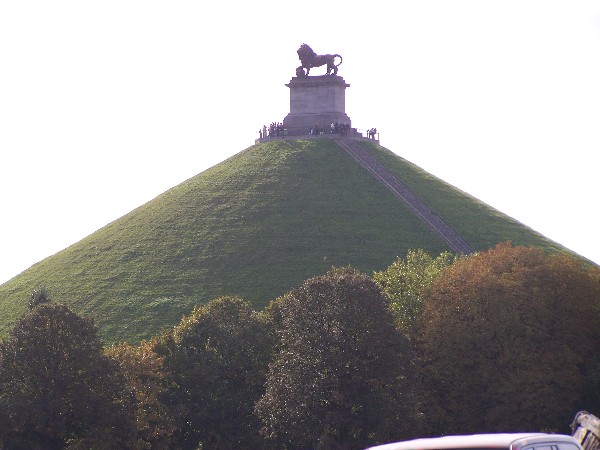
Battle of Waterloo - 18 June 1815 - Napoleon's Final Battle

Waterloo is very nearby and several times we have driven past along the ring road and noticed the Butte du Lion standing tall off to the side. So we decided to study up on the Battle of Waterloo and take a visit to the area. Since it is such a huge part of European history - it put a stop to the French overtaking Europe and caused Napoleon to abdicate the throne - it is fairly "touristy" around the area and at the sites.
We visited all the major parts of the area -
Napoleon's headquarters is a farm a few kilometers south of the battle field,
Wellington's headquarters in Waterloo at an inn there, the battle field with
it's huge Butte du Lion built by the King of Netherlands in honor of his son -
the Prince of Orange - who was wounded on that very spot during the battle, the wax museum, the panorama painting that
puts you into the center of the battle.
that very spot during the battle, the wax museum, the panorama painting that
puts you into the center of the battle.
What impressed us most is the small size of the
area, especially considering that about 360,000 troops and thousands of horses
all fought bravely on this small spot! The battle took place
 mostly
on 3 farms in a very flat area that would have offered little to no cover for
the soldiers on either side. The farm buildings were just about all they
had to protect themselves from each other. I am not exaggerating when I
tell you that the entirety of the battle area, including the rear positions, was
about 4000 meters by 3600 meters (that's about 3700 football fields deep by 3300
football fields wide) - certainly not much space for that many soldiers!
The battle started at about 11:30 that morning and continued until about 8:30
that evening - 9 hours determining the fate of Europe and the turn of history
from what Napoleon has hoped for.
mostly
on 3 farms in a very flat area that would have offered little to no cover for
the soldiers on either side. The farm buildings were just about all they
had to protect themselves from each other. I am not exaggerating when I
tell you that the entirety of the battle area, including the rear positions, was
about 4000 meters by 3600 meters (that's about 3700 football fields deep by 3300
football fields wide) - certainly not much space for that many soldiers!
The battle started at about 11:30 that morning and continued until about 8:30
that evening - 9 hours determining the fate of Europe and the turn of history
from what Napoleon has hoped for.
Curt and Sonya liked figuring out how the battle
played out. At the Wellington Museum there are charts of the battle field
at different points in the day showing how each army had advanced or retreated at that point - we found
it very fascinating to see how it played out.
the day showing how each army had advanced or retreated at that point - we found
it very fascinating to see how it played out.
Several websites are devoted to the area - the main ones are www.museewellington.com and www.trabel.com/waterloo/waterloo.htm .